Biddy Mason Memorial Park in downtown LA is hidden behind a parking lot, an obscure place dedicated to a local icon most Angelenos don’t know.
“We don’t know a lot about African American and women’s history,” explains Brenda Stevenson, professor of history and African American Studies at UCLA. “We still have a narrative that's focused on white men. So there are gaps in our history. And Biddy Mason falls into some of those gaps.”
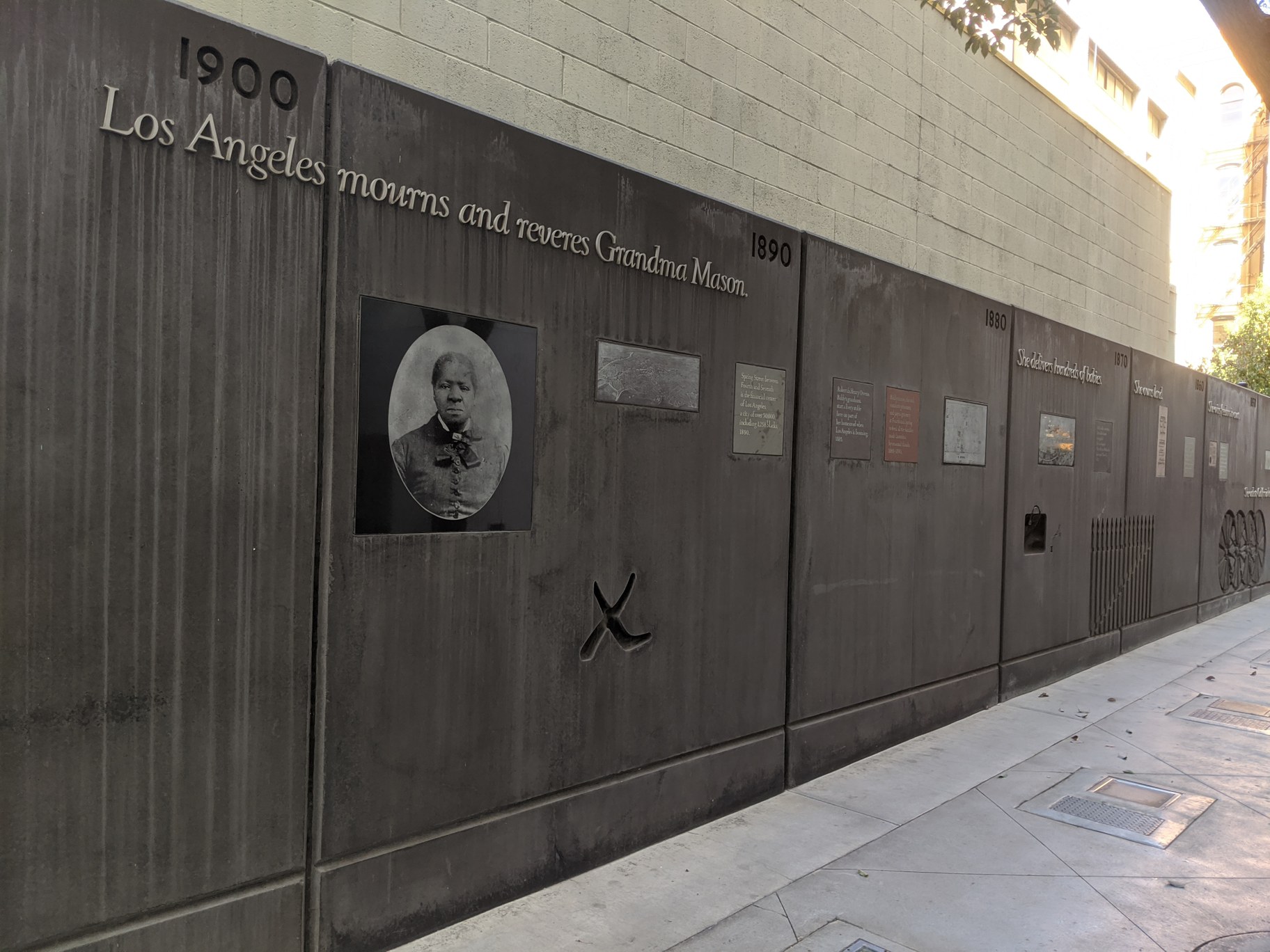
Biddy Mason Memorial Park is located at 333 S. Spring Street. Its featured centerpiece is an 80-foot-long poured concrete wall by artist Sheila Levrant de Bretteville, a timeline of Biddy Mason’s life illustrated by impressions of objects and simple text and images. Photo by Jeremy Thompson (CC BY 2.0).
“This is a person who was born a slave, was able to create something wonderful and lasting in one of the greatest cities in the world. Her story needs to take public space and public consciousness,” Stevenson says.
Sisters Cheryl and Robynn Cox are the great-great-great-great granddaughters of Biddy Mason.
“Biddy Mason was instrumental in the founding of Los Angeles. She laid the groundwork to help build this city,” Cheryl tells KCRW.
Robynn adds, “That’s why we are petitioning the City of Los Angeles to name a street after her.”
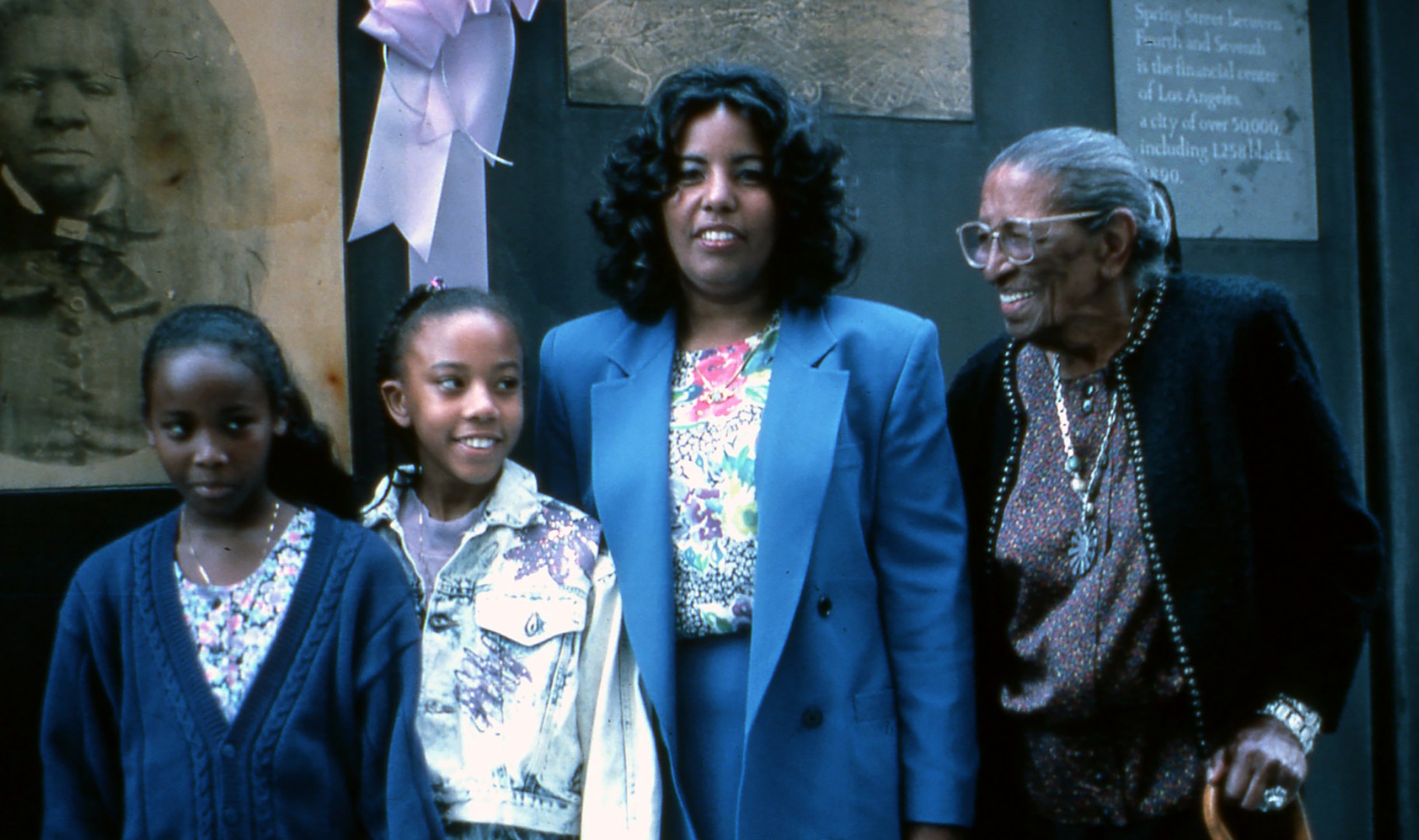
Cheryl and Robynn Cox stand in front of the Biddy Mason Memorial Park wall in 1991. Pictured left to right: Robynn Cox, Cheryl Cox, Linda Cox Brown, Gladys Smith. Photo courtesy of Cheryl and Robynn Cox.
Biddy Mason was born into slavery on August 15, 1818, probably in Georgia. She was given as a wedding gift to Robert and Rebecca Smith, plantation owners in Mississippi. Mason added to their family wealth by giving birth to three daughters — Ellen, Ann and Harriet. She made herself invaluable in the Smith household, learning herbal medicine and practicing skills as a midwife and a nurse.
“She was coming out of this institution that was meant to break you, “ Robynn Cox explains. “She did what she needed to do to keep her family together.”
Mason was in her late twenties when Robert Smith converted to a new religion — Mormonism. He decided to move his family, and all of his property, out west. The Smith caravan traveled on foot from Mississippi to Utah (because they were Mormon), and eventually ended up in Southern California. The trip took nearly three years.
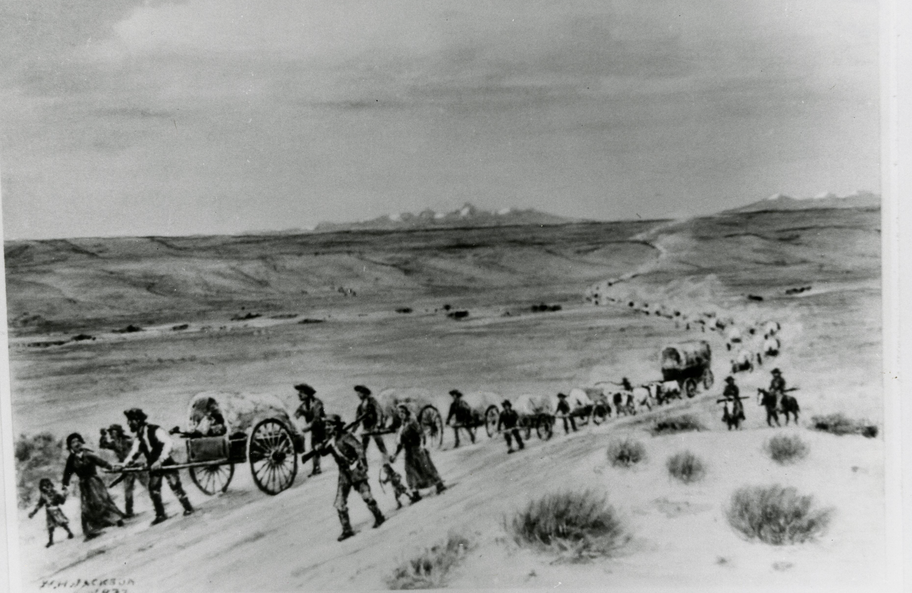
An illustration by William Henry Jackson of pioneers on the Overland Trail. Biddy Mason travelled along the Overland Trail to Salt Lake City on the first leg of her journey. Then she went from Salt Lake down through what would become Utah and Nevada to San Bernardino, California on the second. Photo courtesy of University of Utah Photographic Archives.
In 1851, Los Angeles was a frontier town of about 1600 people. Mason became acquainted with an educated, well-to-do local Black community that informed her California was a “free state” — that she and her family could not be held against their will. In California, Mason and her children were free.
But Robert Smith had no intention of losing his property. He decided to move his entire family — along with all 14 enslaved household members — back to Texas, a slave state.
Stevenson tells KCRW, “When the friends of Mason got the sheriff involved, Smith insisted, “These people are a part of my family, they want to stay with me. They’ve all agreed to stay with me and to move into Texas.’ He was telling them at the same time that, once they got to Texas, they will be free, which is just a bold-faced lie.”
State law did not allow Black people to testify in court. So Judge Benjamin Hayes decided to question Mason outside the courtroom. He asked if she consented to the move. Mason told the judge that she did not.
“If the judge had ruled in Robert Smith’s favor, she could have been put to death,” Cheryl Cox says. “She was going to go out fighting for her freedom.”
It was an act of tremendous courage — and a case of perfect timing.
Just one year later in the infamous case of Dred Scott v. Sandford, the Supreme Court would rule that enslaved people — no matter what state they lived in — were property, not American citizens. “They had no rights which the white man was bound to respect,” Chief Justice Roger B. Taney wrote for the court’s majority opinion.
After Dred Scott, it would’ve been illegal for Mason to assert her rights in court as a free Black woman. But on this day, in this court, Judge Hayes’ decision was unequivocal. “All of the said persons of color are entitled to their freedom and are free forever," he wrote.
Against all odds, Mason sued for her freedom and won.
With her family’s future secure, she went to work as a free woman in Los Angeles. Hired as a midwife and a nurse, she quickly built a reputation as a medical practitioner of outstanding skills, serving both Black and white local communities.
“There were very few doctors in early Los Angeles,” Robynn Cox explains. “That need allowed her to overcome the color line. Let’s face it, when you're sick, you're going to seek help from who has the skills.”
For 10 years, Mason saved her money until she was finally able to purchase a piece of land on Spring Street and establish a family homestead. She was the first Black woman to own property in Los Angeles.
She saved more money and bought more land. She never learned to read or write, and signed all the land deeds with an “X.” As Los Angeles grew up around her family homestead, Mason amassed a fortune in real estate. “She was probably the richest Black woman west of the Mississippi,” Cheryl Cox says.
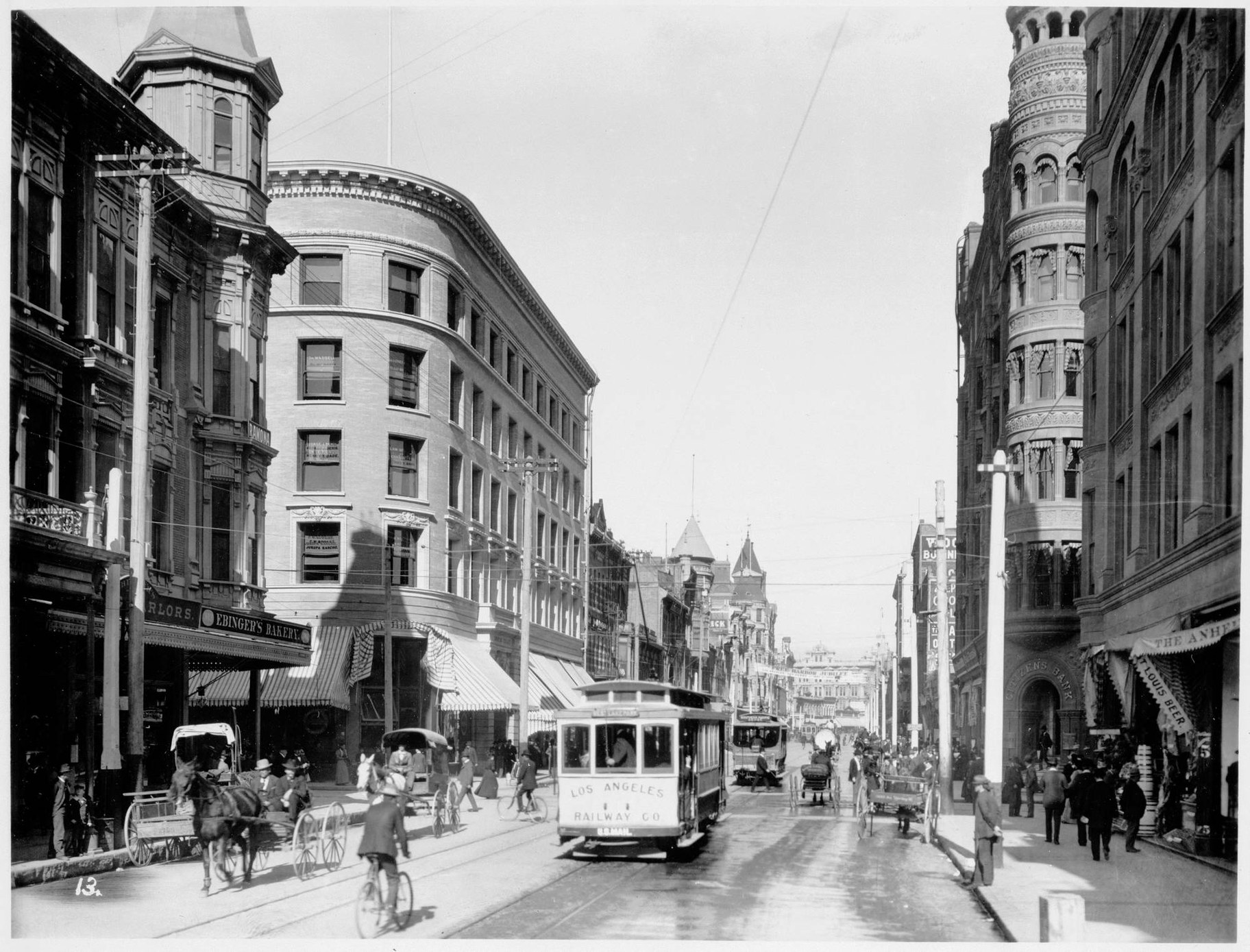
Spring Street seen from Third, appx. 1903. When Biddy Mason bought her first piece of property, she established her family homestead on the outskirts of town on Spring Street. When she died in 1891, Spring Street was the heart of Los Angeles’ thriving financial center. Photo courtesy of Huntington Digital Library.
So what did Mason do with all that money?
“Grandma Biddy had a saying,” Cheryl Cox smiles.
Robynn Cox continues, “‘If you hold your hand closed, nothing good can come in. For the open hand is blessed for it gives in abundance even as it receives.’ It’s actually a biblical principle. God will bless those to help others.”
She left open tabs at local markets so people could come and get whatever they needed. She risked her life treating prisoners in LA jails during an epidemic — the same jail cells she and her family had been forced to live in years earlier.
“Everybody in Los Angeles became her family. There weren't schools for Black people to go to, so she knew that there needed to be schools. There wasn't a church for Black people to worship in, so she knew that she needed to build a church,” Cheryl Cox says.
In 1872, Mason led the founding of the First African Methodist Episcopal Church of Los Angeles, which was started in her living room. She helped build First AME into a cornerstone of the local Black community. It remains so today.
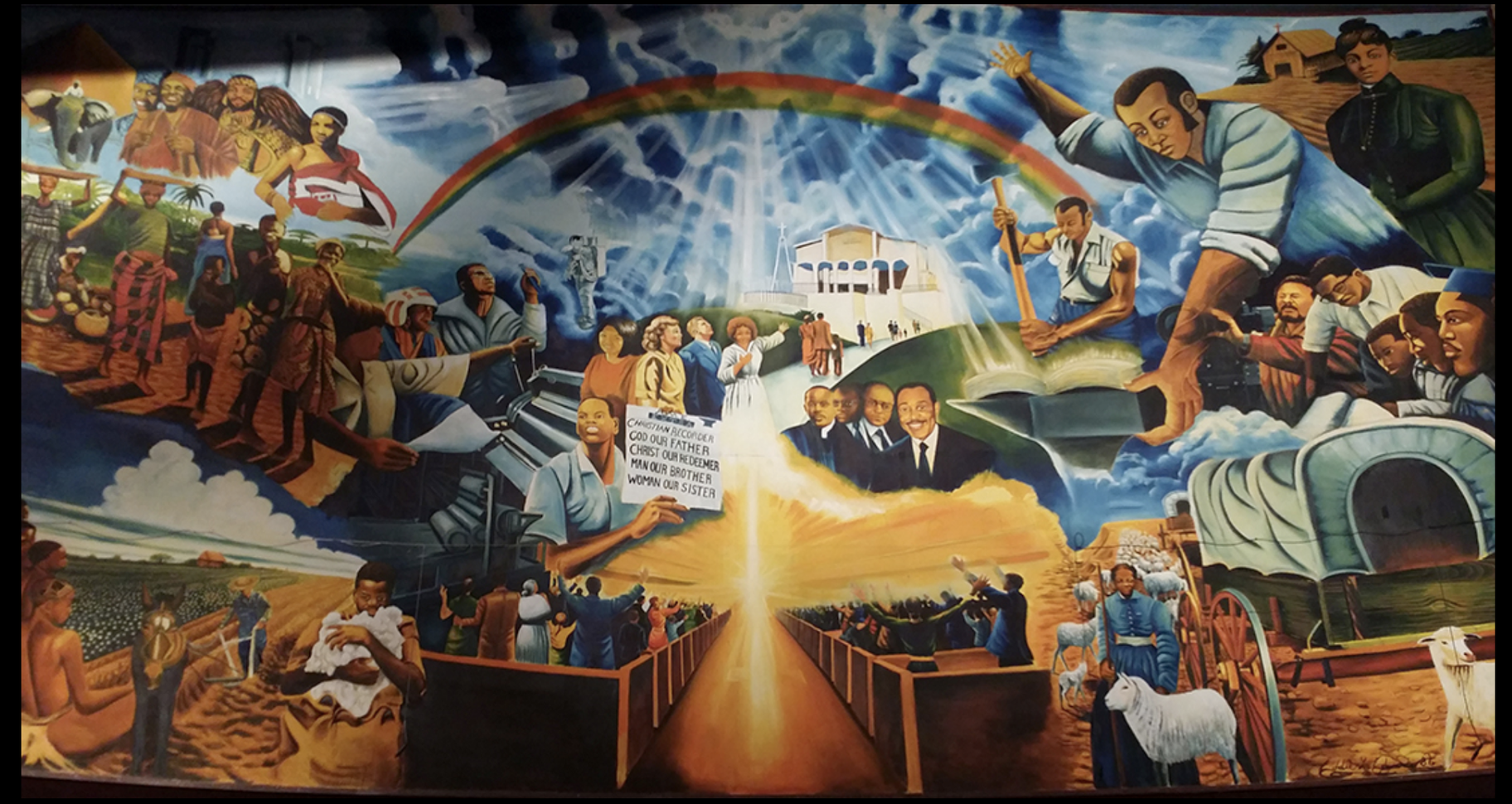
Eddie L. Edwards’ mural at First AME Church of LA shows Biddy Mason in the lower right corner, depicted as a shepherd, on her way to California. Photo courtesy of First AME Church of Los Angeles.
“The mission of First AME has always been first to serve. And that pretty much encapsulates Biddy Mason’s whole take on life,” says Jackie Broxton, a 40-year First AME Church member.
Mason died in 1891 after spending most of her life tending to the needs of the city.
So today, how does the city tend to her memory in return?
“Just the park — and the church. If you don’t understand history, it’s impossible to understand what’s going on now. It’s not right,” Broxton says.
Los Angeles is full of commemorative spaces dedicated to wealthy power brokers and land barons, such as Wilshire Boulevard and Crenshaw Boulevard. There are streets named for William Mulholland plus the two Isaacs — Lankershim and Van Nuys.
But what about all the other people who built Los Angeles?
“Biddy Mason, like most women in the 19th century, was not focused on leaving a public legacy that would live large in the imaginations of people in the future,” Stevenson says. “It's always been important to reclaim the stories of people who have contributed mightily to our society.”
For Cheryl and Robynn Cox, reclaiming the story is personal.
“It has been ingrained in us that it was our responsibility to be the keepers of our family’s legacy,” Cheryl says. "We petitioned the city to change the name of Spring Street.”
“This is where her homestead was,” Robynn adds. “We are hoping that Los Angeles will rename Spring Street in her honor.”

This street sign is located at the northeast corner of Spring and Fourth streets in downtown LA, just south of Biddy Mason Memorial Park. Cheryl and Robynn Cox want to rename Spring Street after their great-great-great-great grandmother. Photo by Mike Schlitt.
Can changing a name change public memory? Brenda Stevenson thinks so.
Renaming Spring Street after Biddy Mason is perfect, she says. “If we are to shift our understanding of American history to one that includes all of the people who have helped to build the United States of America, then we need to dedicate more public space to understanding what that history is.”
Commemorating a past to construct a better future may sound pie in the sky, but if you want inspiration to do what seems impossible, consider the story of Biddy Mason.
This is part of Greater LA’s series on local streets — how they got their names and what they say about past and present life here.
